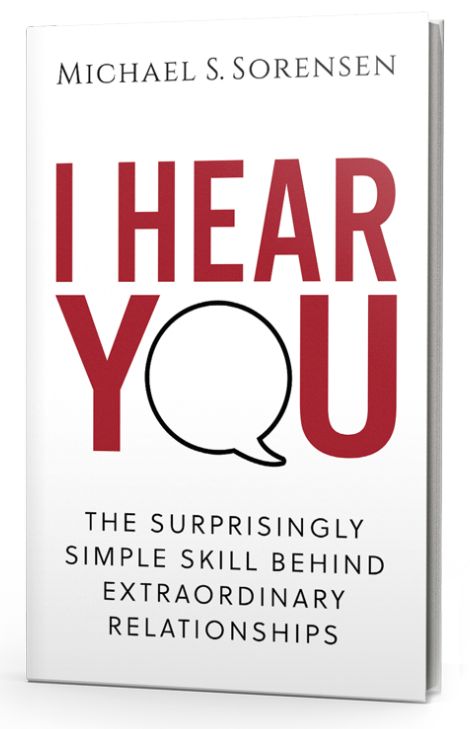by Ryan H. Law
When I got married I quickly learned that my wife didn’t want my advice or for me to fix her problems (unless she specifically asked me to). She wanted to be listened to, understood, and validated.
It turns out that is what most people are looking for. In Michael S. Sorensen’s book, “I Hear You!” he says that validation is the simple skill behind extraordinary relationships1.
Focusing on building amazing (or extraordinary) relationships has always been of interest to me as a husband, father, teacher, leader, and in all of my other roles. After all, what is more important than the relationships we build?
Validation requires several other important skills: active listening, empathy, clarification, connecting, and a genuine interest in other people.
It is not about fixing things, or reassuring people, or offering advice. It is about helping people see that the emotions they are feeling are okay and understandable, and that they have every right to feel those emotions.
Let’s jump right to an example. Imagine a client called in and is upset because their portfolio dropped in value:

Client: “I’m so upset! My portfolio is down 25% this year! This is all your fault!”
Many people would get defensive at this point:
Advisor: “Calm down, Jack. It’s a temporary setback, and a common correction in the market. That is further than I thought it would drop, but everything is on track. Calling in angry doesn’t help anything.”
How is Jack going to take that? He is most likely going to get defensive and is definitely not going to “calm down.”
We’ll come back to this example in a minute.
Validating is actually the third step in a process.
According to Sorensen, “The truly good listeners of the world do more than just listen. They listen, seek to understand, and then validate.”
Sorensen identifies two steps for effective validation:
- Identity a specific emotion
- Offer justification for that emotion
In our example about the market dropping 25% we can identify the emotion, which is easy because the client told you. They are feeling upset. It most likely goes deeper than that – they are worried and they want someone to blame.
Validating does not need to take long or be difficult. Sorensen offers a number of examples of validating responses:
- “Wow, that would be really confusing.”
- “He really said that? I’d be angry too!”
- “Ah, that is so sad.”
- “I totally get why you feel that way; I’ve been in a similar situation and it was rough.”
Validation should be offered anytime someone expresses an emotion, including positive emotions. For example, when someone is happy or proud you could respond with:
- “You have every right to be proud; that was a major accomplishment.”
- “I’m so happy for you! You’ve worked incredibly hard on this. It must feel amazing.”
Unfortunately people often offer invalidating responses when someone expresses an emotion. For example:
- “You’ll be fine.”
- “Don’t worry about it.”
- “It could be worse.”
- “Just tough it out.”
- “It’s not that big of a deal.”
- “Stop complaining.”

Sorensen believes that 80-90% of conversations have at least one opportunity to validate. People crave validation.
Validation seems easy when the person is upset or angry or frustrated about something that has nothing to do with you, but what happens when, as in our example, the person is upset with you?
We still validate and offer empathy and use curiosity to dig deeper. Let’s look at how our example scenario might go with empathy, curiosity, and validation.
Client: “I’m so upset! My portfolio is down 25% this year! This is all your fault!”
Advisor: “I can understand why you are upset. 25% is a big drop in value.”
Client: “Yeah! And it’s your fault. You told me that this portfolio would be best for my retirement funds.”
Advisor: “That’s true, I did recommend that, so I can see why you would blame me.”
Client: “So what are you going to do about it?”
Advisor: “Can you give me a second while I grab your file?”

NOTE: This idea, from Carl Richards, gives you a moment to gather any needed information, and gives the client a moment to calm down.
Client: “Sure.”
NOTE: It is easy to want to get into a technical discussion here about diversification, and their how their portfolio has performed compared to the overall market, and missing the seven best days in the market, and the overall rise of the market over long periods of time, but that client doesn’t need or want that at this point. They want to be validated. A deeper discussion about their risk tolerance level and their portfolio is probably warranted, but not at this point.
Advisor: “I have your file here. It looks like it has been almost a year since we last met. A lot can change in a year, and I think it would be beneficial for us to meet and we can discuss this in more detail.”
Client: “I think that is a good idea. I’m really unhappy with the drop in value.”
Advisor: “I totally get why you feel that way. I have my money in a similar portfolio, and it’s been a bumpy year. I’m not happy with the drop in value in my portfolio either. How does Wednesday work for you?”
At this point the client should feel listened to, understood, and validated, and that is all that is needed at this point. They may still be upset when they come in, but it will be a different type of conversation.
ACTION STEP:
- Sorensen said that 80-90% of conversations have at least one opportunity to validate. In your next conversation, listen carefully, seek to understand, then validate.

REFERENCES & RESOURCES:
(1) Sorensen’s book is one that should be on your shelf and referred to as part of ongoing communication training.
Images in this post are licensed by Ingram Image – Stock Photo Secrets (AFF)



Leave a Reply